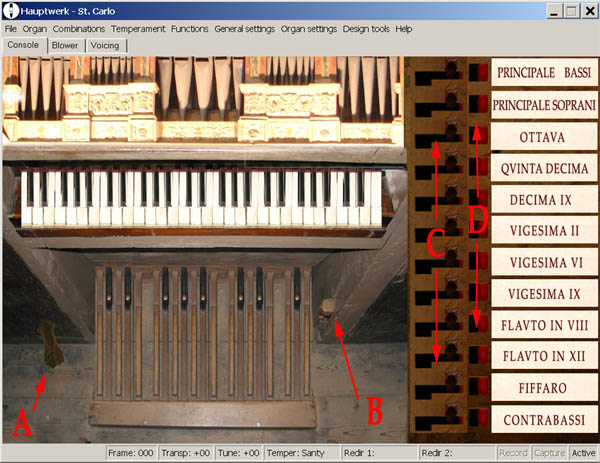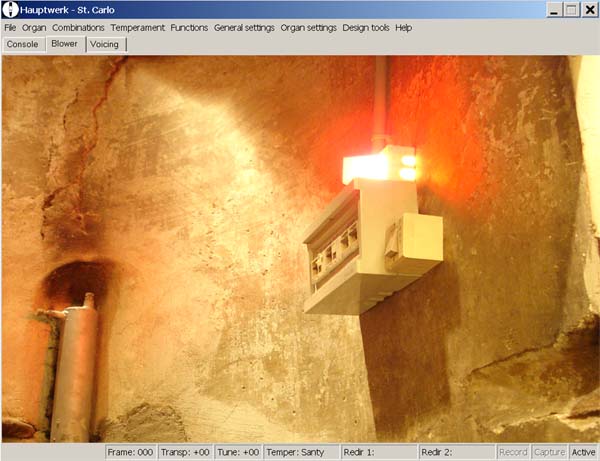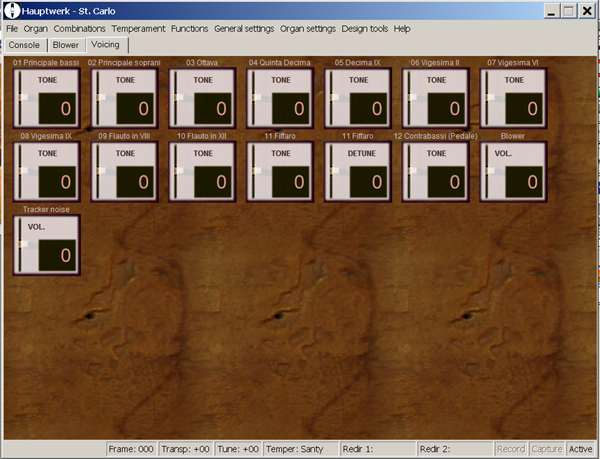Sonus Paradisi
Brescia, ca. 1600 [Hauptwerk]
Brescia, ca. 1600 [Hauptwerk]
Couldn't load pickup availability
Antegnati organ in St. Carlo, Brescia, Italia (XVI. - XVII. century)
"Antegnati" - the name of the proliferous family of the organbuilders in northen Italy is known to everyone who came in contact with the Italian organ music. They were active through XVth to XVIIth century. Their organs are the typus of the Italian organ building school.
In addition to the full principal chorus the "Ripieno", there are concertant stops, usually represented by the Flute quint (Flauto in duodecima) = a Nazard, and a "recorder"-like voiced Flauto in ottava. The pedal is usually hardcoupled to the manual without any proprietary stops. In the case of St. Carlo, there is one pedal stop named Contrabassi (Subbas 16') which was added in the course of the history.
The undulating "celeste" stop Fiffaro should be used - according to the Antegnati advice - only in conjunction with the Principale to produce the beating effect and it is recommended for the slow movements.
Presented to you by Leonart Studio, your authorised reseller for Sonus Paradisi in Switzerland (shipped internationally). Get your digitally sampled historical organs for the use with the Hauptwerk virtual instrument software.
Share this Sample Set
![Brescia, ca. 1600 [Hauptwerk]](http://artful.shop/cdn/shop/files/ss_brescia1.jpg?v=1692999981&width=1445)
Specification (stop list)
-
Manual I
Principal chorus = Ripieno
Principale bassi 8'
Principale soprani 8'
Ottava 4'
Quinta decima 2'
Decima nona 1 1/3'
Vigesima II 1' (repetions from 67-G, 79-G)
Vigesima VI 2/3' (repetitions from 60-C, 73-C#)
Vigesima IX 1/2' (repetitions from 55-G, 67-G, 79-G)
Flutes
Flauto in VIII 4'
Flauto in XII 2 2/3' (Nasard)
Beating stop
Fiffaro 8' -
Manual II
-
-
Manual III
-
-
Manual IV
-
-
Pedal
hard coupled
Contrabassi 16' -
Other specification
The Fiffaro 8' (descant, beating principal stop) is to be used with Principale only according to the Antegnati suggestions.
The three "vigesimas" together form what we today call a mixture.
The ranks of traditional Italian organs break at about 1/6' or 1/8' pipe length an octave down making an octave repetitions. This produces a preponderance of 2' and 2 2/3' pitches in the upper part of the compass of the Ripieno. For further information, see the C. Jonson's or Barbara Owen's book mentioned in the history section of this web.
History
Antegnati organ in St. Carlo, Brescia, Italia (XVI. - XVII. century)
"Antegnati" - the name of the proliferous family of the organbuilders in northen Italy is known to everyone who came in contact with the Italian organ music. They were active through XVth to XVIIth century. Their organs are the typus of the Italian organbuilding school.
By the end of XVIth century, the Italian organ assumed the stable form which persisted through the next two centuries. Usually, it had one manual with very primitive pull-down pedal. The basis of the organ was formed by the full "pyramid" of the principal chorus, separating each rank even in the highest registers. Therefore, there is no "mixture" stop found on traditional Italian organ. Instead, the brilliant "crown" of the organ sound is formed by individual principal ranks with the latin names designating their height (15th, 19th, 22nd, 26th, 29th...). As the Italian organbuilders did not build very small pipes, the stops usually break at the 1/8' of the pipe length, sometimes even lower, making an octave repetitions. Therefore, the plenum is dominated by the 2' and 2 2/3' sound, giving a "golden" timbre (while the German type of the organ plenum could be described as "silver").
In addition to the full principal chorus the "Ripieno", there are concertant stops, usually represented by the Flute quint (Flauto in duodecima) = a Nazard, and a "recorder"-like voiced Flauto in ottava. The pedal is usually hardcoupled to the manual without any proprietary stops. In the case of St. Carlo, there is one pedal stop named Contrabassi (Subbas 16') which was added in the course of the history.
There are several theories about the origin of the organ in S. Carlo in Brescia. Gilles Cantagrel suggests that the organ was built by Gian Giaccomo Antegnatiat the end of 16th century. Another source attributes the instrument to Graziadio Antegnati who would build the organ "during the first years of XVIIth century". Finally, the modern label located on the organ case reads: "This instrument was built in 1636 by Antegnati organbuilding workshop in Brescia. It was restored by Armando Maccarinelli in 1958 under the technical direction of Luigi Ferdinando Tagliavini and Ernesto Meli."
If further clarification are possible, I would be gratefull for letting me know.
René Saorgin describes the St. Carlo instrument as the ideal of the Antegnati's work: The timbre of its 8 feet Principale is, as the organbuilder himself required, very "cantable" and "delicate". I would describe its sound as "mild". The low pressure of the air (lower than 2 inches) does not "overdrive" the pipe so it is very naturally speaking without any shadow of force or pressure. It reminds me of the Baroque Salicional (not the modern "stringy" Salicional, though!!!) or even Gemshorn.
The referrence is made to the treatise of Costanzo Antegnati "L'Arte organica" from 1608, where the famous organbuilder gives his observations and suggestions for the organ performance. His remarks are extremely important for the authentic interpretation of early Italian music.
Also the aliquote stops of the principal chorus are gently voiced which gives a subtle and "harpsichord"-like timbre to the whole Ripieno. The aliquotes are used for coloring the Principale fundamental. When performing the music using this sample set, you should not turn the volume too much up!
The undulating "celeste" stop Fiffaro should be used - according to the Antegnati advice - only in conjunction with the Principale to produce the beating effect and it is recommended for the slow movements.
Further reading:
Oscar Mischiati (ed.), GLI ANTEGNATI: Studi e documenti su una stirpe di organari bresciani del Rinascimento. Bologna, 1995.
Calvert Johnson, Historical Organ Techniques and Repertoire: ITALY 1550-1650. Colfax: LWE, 2002.
Ferdinand Klinda, Organ v kultúre dvoch tisícročí. Bratislava: HC, 2000.
Barbara Owen, The registration of Baroque Organ Music. Bloomington and Indianapolis: Indiana University Press, 1997.
The French-British TV document by Gilles Cantagrel, Une histoire de l'Orgue. 1. part, 1990.
Features
Hauptwerk v.4.2 and higher supported.
24bit, 48kHz samples, multi-sample technology (each tone has 3 independent samples which are chosen at random for playback each time the key is pressed - this results in greater variety of sound).
Virtually noiseless - no disturbing noise in the samples or in the reverb.
Multi-sampling (up to 5 independent attack samples per single tone for more vivid sound - each time you press the same key, a different sample can play back for a given stop)
Multi-release (up to 4 release samples for a single attack sample depending on how long you keep the key pressed - it effectively removes the known "staccato effect".)
Original (short-octave) and Extended (chromatic bass octave) versions of the sample set available.
Compass
manual - 4 and half octaves (MIDI: 36-C to 89-F). In the original version, the lowest octave is "short", meaning that it is only diatonic C-D-E-F-G-A-B-H. In the extended version, the chromatic semitones were added.
pedal - 20 keys (MIDI: 36-C to 55-G), 12 pipes (high octave repeats the low tones), hard coupled to manual
Temperament
Historical tuning is lost, equal tuning is applied to the organ now. However, by using various tuning charts available in Hauptwerk 2 or 3, you can retune the instrument to the desired historical tuning.




Requirements
Hauptwerk v.4.2 and higher supported.
RAM consumption
Hauptwerk single release, 16-bit, full reverb, compressed: 1 839 MB
Hauptwerk multi release, 16-bit, full reverb, compressed: 2512 MB
Hauptwerk, multi release, the highest quality loading (24-bit): 3.1 GB
MyOrgan (with memory compression): 732 MB
This Hauptwerk Sample Set is presented to you by Leonart Studio, an authorised reseller for the manufacturer Sonus Paradisi in Switzerland (shipping internationally). Enjoy this digitally sampled organ library for the use with Hauptwerk software and start expanding your historical organ collection today.
More Hauptwerk Sample Sets
-
Schwerin, Dom, Ladegast Organ 1871 [Hauptwerk]
Vendor:Sonus ParadisiRegular price CHF 616.00Regular priceUnit price / per -
Segovia, 1772 [Hauptwerk]
Vendor:Sonus ParadisiRegular price CHF 317.90Regular priceUnit price / per -
Groningen, 1450-1740 [Hauptwerk]
Vendor:Sonus ParadisiRegular price From CHF 658.90Regular priceUnit price / perCHF 1,681.90Sale price From CHF 658.90Sale -
St. Maximin, 1775 [Hauptwerk]
Vendor:Sonus ParadisiRegular price CHF 440.00Regular priceUnit price / per -
Reuter, 1928 [Hauptwerk]
Vendor:Sonus ParadisiRegular price CHF 473.00Regular priceUnit price / per -
Casavant, 1995 [Hauptwerk]
Vendor:Sonus ParadisiRegular price CHF 174.90Regular priceUnit price / per -
Rotterdam Hoofdorgel, 1973 [Hauptwerk]
Vendor:Sonus ParadisiRegular price From CHF 330.00Regular priceUnit price / perCHF 958.10Sale price From CHF 330.00Sale -
Piacenza, 1838 [Hauptwerk]
Vendor:Sonus ParadisiRegular price CHF 330.00Regular priceUnit price / per -
Bückeburg, 1997 [Hauptwerk]
Vendor:Sonus ParadisiRegular price From CHF 1.10Regular priceUnit price / per -
Lüdingworth, 1683 [Hauptwerk]
Vendor:Sonus ParadisiRegular price CHF 330.00Regular priceUnit price / per


![Schwerin, Dom, Ladegast Organ 1871 [Hauptwerk]](http://artful.shop/cdn/shop/files/ladegast1.jpg?v=1759140126&width=533)
![Segovia, 1772 [Hauptwerk]](http://artful.shop/cdn/shop/files/ss_segovia1.jpg?v=1714213906&width=533)
![Groningen, 1450-1740 [Hauptwerk]](http://artful.shop/cdn/shop/files/ss_Groningen1.jpg?v=1693275425&width=533)
![St. Maximin, 1775 [Hauptwerk]](http://artful.shop/cdn/shop/files/ss_maximin1.jpg?v=1692902597&width=533)
![Reuter, 1928 [Hauptwerk]](http://artful.shop/cdn/shop/files/ss_Reuter1.jpg?v=1693321024&width=533)
![Casavant, 1995 [Hauptwerk]](http://artful.shop/cdn/shop/files/ss_casavant1.jpg?v=1693319885&width=533)
![Rotterdam Hoofdorgel, 1973 [Hauptwerk]](http://artful.shop/cdn/shop/files/ss_RotterdamMain1.jpg?v=1693279529&width=533)
![Piacenza, 1838 [Hauptwerk]](http://artful.shop/cdn/shop/files/ss_piacenza1.jpg?v=1693003521&width=533)
![Bückeburg, 1997 [Hauptwerk]](http://artful.shop/cdn/shop/files/ss_bueckeburg1.jpg?v=1692967628&width=533)
![Lüdingworth, 1683 [Hauptwerk]](http://artful.shop/cdn/shop/files/ss_luedingworth1.jpg?v=1692998051&width=533)